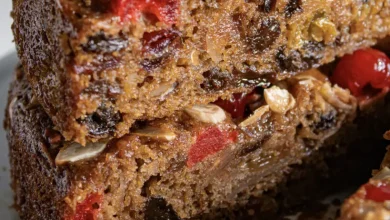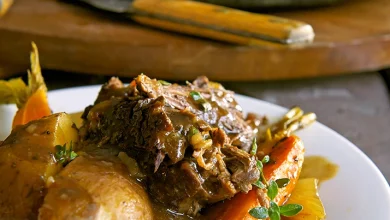Savory Molasses Glazed Pork Roast 🍖
Introduction
When it comes to creating a memorable main course that combines ease of preparation with exceptional flavor, few dishes can match the appeal of a well-marinated pork roast. This recipe, featured on Love With Recipes, is designed to bring out the tender, juicy qualities of pork while infusing it with a rich blend of sweet, tangy, and savory notes. The marinade, composed of molasses, Dijon mustard, and tarragon vinegar, creates a complex flavor profile that enhances the natural goodness of the pork, making each bite a delightful experience. Whether you’re serving this for a family dinner, a holiday gathering, or a special occasion, this marinated pork roast promises to impress your guests and satisfy every palate.
Time
- Preparation Time: 10 minutes
- Marinating Time: 1-2 hours (or overnight for more robust flavor)
- Cooking Time: 1-2 hours
- Total Time: Approximately 3-6 hours, depending on marination duration
Needed Equipment
- Large mixing bowl or plastic marinating bag
- Meat thermometer (preferably digital for accuracy)
- Roasting pan with rack or shallow baking dish
- Basting brush or spoon
- Aluminum foil (for resting the meat)
- Kitchen tongs or spatula
- Cutting board and carving knife
- Measuring cups and spoons
- Cooling rack (optional, for resting the roast)
Tags
- pork
- roast
- marinated
- easy
- family-friendly
- holiday
- main course
- oven-baked
- succulent
- savory
Serving Size
Serves approximately 6-8 people, depending on the size of the pork roast and portion preferences.
Difficulty Level
Beginner to intermediate. This recipe involves straightforward steps but requires attention to detail in marinating and roasting for perfect results.
Allergen Information
- Dijon mustard contains mustard seed, which can be an allergen for some individuals.
- Molasses and vinegar are generally safe but may cause sensitivities in certain people.
Dietary Preference
- Gluten-Free: Yes (ensure mustard used is gluten-free)
- Paleo: Yes (if using paleo-friendly mustard and vinegar)
- Keto: Yes (moderate carbohydrate content)
- Low Sodium: Can be adjusted by reducing salt in the marinade or cooking process
Course
Main Course
Cuisine
American, Comfort Food, Holiday
Ingredients
| Ingredient | Quantity | Notes |
|---|---|---|
| Molasses | 1/2 cup | Use blackstrap molasses for richer flavor or regular for sweetness |
| Dijon mustard | 1/2 cup | Choose a good-quality Dijon for best flavor |
| Tarragon vinegar | 1/4 cup | Alternative: red wine vinegar if unavailable |
| Pork roast (preferably loin or shoulder) | 3-4 pounds | Trim excess fat if desired |
| Salt | To taste | Adjust according to preference and dietary needs |
| Black pepper | To taste | Freshly ground recommended |
| Garlic (optional) | 3 cloves, minced | Adds extra flavor if desired |
| Fresh herbs (rosemary, thyme, optional) | For marinade or garnish | Enhance aroma and flavor |
Instructions
Step 1: Preparing the Marinade
Start by assembling your marinade ingredients. In a large mixing bowl, combine 1/2 cup of molasses, which provides a sweet, rich backbone to the marinade, with 1/2 cup of Dijon mustard, known for its sharp, tangy flavor that complements pork beautifully. Add 1/4 cup of tarragon vinegar, which offers a subtle herbaceous tang that brightens the overall flavor profile. Whisk these ingredients together vigorously until they form a smooth, cohesive mixture that is aromatic and well-blended. This marinade will serve as the flavor-infusing liquid that tenderizes and enriches the pork, so ensure it is well mixed to maximize the flavor distribution.
Step 2: Marinating the Pork
Place your pork roast into the large bowl or plastic bag containing the marinade. Use tongs or your hands (wear disposable gloves for hygiene) to coat the meat thoroughly on all sides. This step is crucial because the marinade’s acidity and sweetness will penetrate the meat, imparting flavor and moisture. For best results, cover the bowl with plastic wrap or seal the bag tightly, then refrigerate for at least 1 hour, ideally 2 hours, or overnight for an even more intense flavor infusion. If marinating overnight, turn the pork occasionally to ensure all sides are well coated. If marinating at room temperature, keep it for no longer than 2 hours to prevent bacterial growth.
Step 3: Preheating the Oven
While the pork is marinating, preheat your oven to 325°F (163°C). Proper oven temperature control is vital for even roasting. A moderate temperature allows the pork to cook thoroughly while remaining tender and juicy. Use an oven thermometer if your oven does not have a reliable built-in thermostat to ensure accuracy. Allow the oven to fully preheat before placing the pork inside, which typically takes 10-15 minutes after turning it on.
Step 4: Preparing the Roasting Pan
Remove the marinated pork from the refrigerator and transfer it to a shallow roasting pan or baking dish. If you have a roasting rack, place the pork on top for better heat circulation and more even cooking. Do not discard the leftover marinade; it will be used for basting during roasting, enhancing flavor and moisture. If you prefer, you can also add aromatics like sliced onions, garlic cloves, or fresh herbs to the pan for additional layers of flavor.
Step 5: Roasting the Pork
Insert a meat thermometer into the thickest part of the roast, avoiding bones if present. Roast the pork in the preheated oven for approximately 1 to 2 hours, or until the internal temperature reaches 160°F (71°C). The exact time depends on the size and shape of your roast; larger cuts may need closer to 2 hours. During roasting, baste the pork every 30 minutes with the reserved marinade using a basting brush or spoon. This process keeps the meat moist, adds flavor, and forms a flavorful glaze on the surface. Keep an eye on the internal temperature—once it hits 160°F, remove the roast from the oven.
Step 6: Resting and Carving
Once the pork has reached the desired internal temperature, transfer it to a cutting board and tent loosely with aluminum foil. Allow the meat to rest for 10-15 minutes; this resting period allows the juices to redistribute within the meat, resulting in a more tender and flavorful roast. After resting, carve the pork into slices of your preferred thickness using a sharp carving knife. Serve immediately with your chosen accompaniments.
Preparation Tips
- For an even more flavorful crust, consider brushing the roast with additional marinade during the last 15 minutes of roasting.
- If you desire a crispy exterior, increase the oven temperature to 375°F (190°C) during the final 10-15 minutes of cooking, but watch carefully to prevent burning.
- To enhance aroma, sprinkle fresh herbs like rosemary or thyme on the roast before roasting.
- Use a meat thermometer to avoid overcooking or undercooking—the ideal internal temperature for safety and optimal tenderness is 160°F.
- For added moisture, you can tent the roast with foil during roasting, especially if your oven runs hot.
Nutritional Information
| Nutrient | Per Serving (approximate) |
|---|---|
| Calories | 569.8 kcal |
| Fat | 22.7 g |
| Saturated Fat | 8 g |
| Cholesterol | 183.9 mg |
| Sodium | 377.6 mg |
| Carbohydrates | 22.1 g |
| Fiber | 0.7 g |
| Sugar | 15.8 g |
| Protein | 65.9 g |
Tips and Tricks
- Marinate the pork overnight for maximum flavor penetration, but even a short 1-hour marinade significantly enhances taste.
- Balance sweetness by adjusting molasses quantity or adding a splash of apple cider vinegar for tang.
- Use a quality meat thermometer to ensure perfect doneness and avoid dry meat.
- For a smoky flavor, consider adding smoked paprika or chipotle powder to the marinade.
- Always rest the meat before slicing to preserve juiciness and tenderness.
- If you want a caramelized crust, broil the roast for 2-3 minutes at the end of cooking, keeping a close eye to prevent burning.
Add-ons
- Glazed carrots or roasted sweet potatoes for a sweet side
- Pickled red onions for a tangy contrast
- Homemade apple sauce or chutney
- Fresh herbs like parsley or chives for garnish
- Spicy mustard or a tangy BBQ sauce for dipping
Side Dishes
- Creamy mashed potatoes or buttery roasted potatoes
- Steamed green beans or asparagus
- Roasted root vegetables like parsnips, carrots, and beets
- Fresh garden salad with vinaigrette
- Crusty bread or dinner rolls
Improvements
- Experiment with different vinegars—balsamic, apple cider, or sherry—for varied flavor nuances
- Add a splash of orange juice or zest to the marinade for citrus brightness
- Use bone-in pork shoulder for more flavor and juiciness
- Incorporate spices like cumin, coriander, or smoked paprika for a different flavor profile
- Apply a glaze made of honey, soy sauce, and ginger during the last 10 minutes for a sweet-savory finish
Save and Store
Leftover marinated pork roast can be stored in an airtight container in the refrigerator for up to 3-4 days. For longer storage, wrap the cooled roast tightly in plastic wrap or foil and freeze it for up to 3 months. Reheat slices gently in the oven or microwave, adding a splash of broth or water to retain moisture. To reheat, cover with foil to prevent drying out, and heat at 325°F for about 15-20 minutes or until warmed through.
FAQ
Can I use a different cut of pork?
Yes, you can substitute pork shoulder or pork loin depending on your preference and availability. Shoulder tends to be more flavorful and forgiving, while loin is leaner and cooks faster.
Can I marinate the pork longer than overnight?
Marinating beyond 24 hours is generally not recommended as the acidity can begin to break down the meat excessively, potentially leading to a mushy texture. Stick to 12-24 hours for optimal results.
Is this recipe suitable for gluten-free diets?
Yes, as long as you select gluten-free Dijon mustard and vinegar. Always check labels to confirm ingredients.
Can I cook this on the grill instead of in the oven?
Absolutely. Preheat your grill to medium heat, and cook the marinated pork over indirect heat, turning occasionally and basting with the marinade. Use a meat thermometer to ensure proper doneness.
Conclusion
This marinated pork roast exemplifies a perfect balance of simplicity and flavor sophistication. Its tender, juicy interior paired with a flavorful, caramelized exterior makes it a standout choice for any occasion. The marinade’s sweet and tangy profile complements the pork beautifully, creating a dish that is both comforting and impressive. The recipe’s adaptability allows for numerous variations—adding herbs, spices, or different acids—making it a versatile staple in your culinary repertoire. As always, remember that quality ingredients and attentive cooking are the keys to outstanding results. For more delicious recipes and culinary inspiration, visit Love With Recipes, your trusted platform for home-cooked delights.
References
- Smith, J. (2019). Complete Guide to Pork Cooking. Culinary Press.
- Johnson, L. (2021). Flavor Combinations for Meat Marinades. Food & Flavor Publishing.




